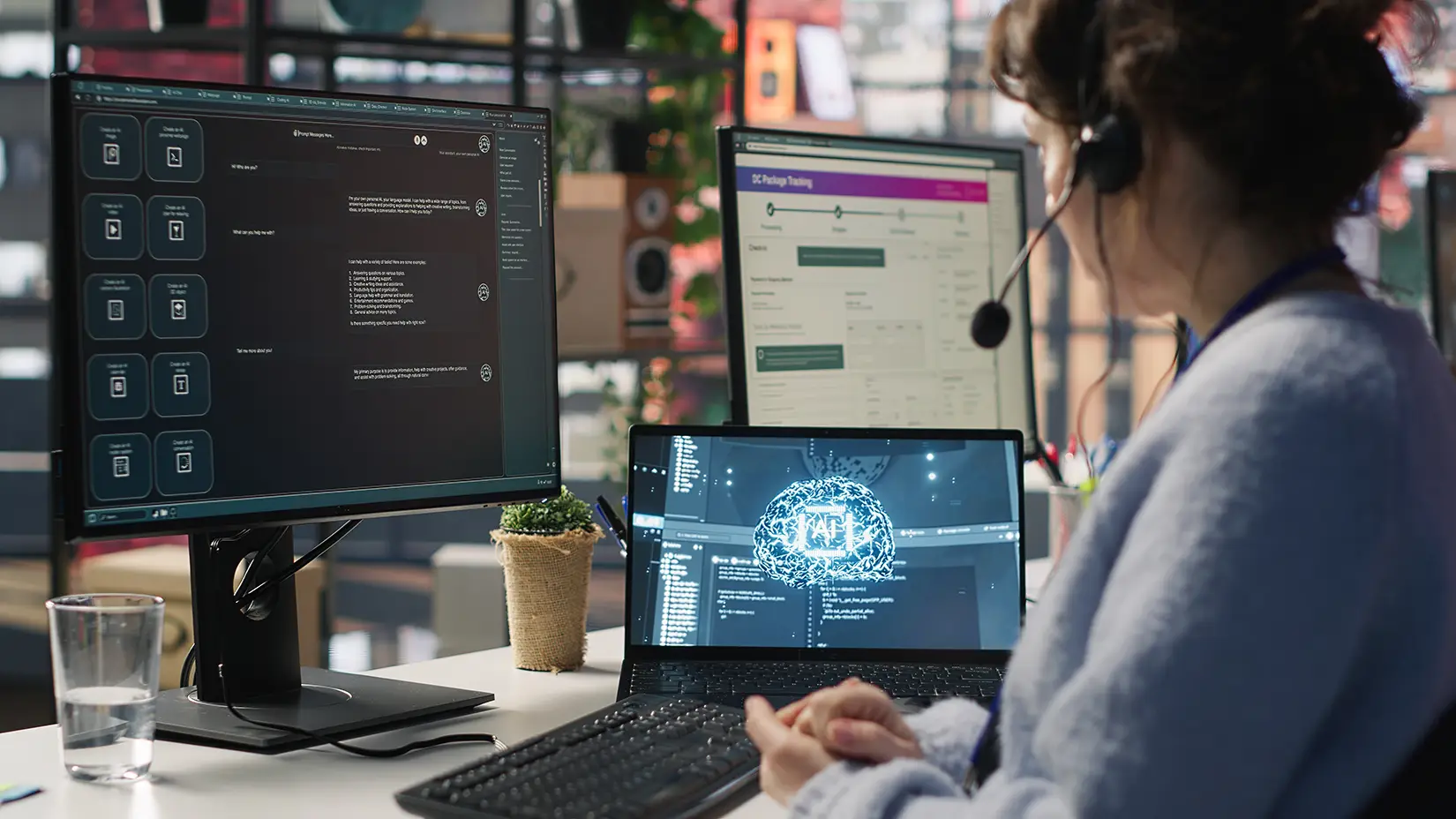What if your tech stacks could talk to each other and make decisions, even when you’re away from your desk?
Imagine having a customer onboarding process that runs itself, payment processes you don’t have to chase, and operations that scale smoothly as your business grows.
The result? A more productive employee, happier customers, and a strong profit margin.
Well, you may have automated parts of your workflow, but basic automation can only take you so far. It falls short when dealing with dynamic tasks, multiple systems, and situations that require intelligent decision-making. That’s where hyperautomation comes in.
In this article, we’ll break down everything about hyperautomation, its application to your business, and how to start using it to streamline your processes and boost your growth.
What Is the Meaning of Hyperautomation?
Automation = repetitive task automation (basic)
Hyperautomation = end-to-end business process automation (comprehensive)
It’s easy to think of hyperautomation as an extra layer of automation. It’s more advanced and complex. It involves orchestrating multiple technologies such as artificial intelligence (AI), machine learning (ML), and robotic process automation (RPA) to optimize business operations.
Think of it like this: you make coffee every morning at 7 a.m., but you have a computer set up to watch your process daily. One day, it starts by offering you a cup, then boils the water, and over time, it learns to make the coffee entirely on its own. Then, another time, it wakes you up with a cup of coffee without any instructions. That’s hyperautomation! It learns, adapts, and acts.
In a business world, instead of automating individual aspects of a business process separately, hyperautomation connects these systems into a unified tech stack.
The term “hyperautomation” came into existence in 2019 when Gartner addressed the common challenges of robotic process automation, which include short-sighted, fragmented, and unscalable strategies. It became a strategic framework that balances repetitive business operations automation, business process management, and digital operations. In the long run, this leads to improved work quality, faster execution time, and agile decision-making. Gartner also predicts that its adoption would increase, and by 2026, 30% of enterprises will automate more than half of their network activities.
Hyperautomation refers to an effective combination of complementary sets of tools that can integrate functional and process silos to automate and augment business processes.
– Gartner
Hyperautomation Technologies
Today, technology is no longer simulating human intelligence. It’s enabling capabilities beyond what individuals can do on their own. As hyperautomation combines multiple technologies to eliminate repetitive processes, your team can have more time to do the work that moves the needle (making them superhumans).
Here are the key technologies that drive hyperautomation:
- Process mining: This involves using discovery tools to monitor event logs to identify business processes where automation could be more beneficial. It shows you inefficiencies, bottlenecks, and opportunities for automation, giving you a data-backed map of your workflows.
- Robotic process automation (RPA): This is the center of intelligence for automating repetitive tasks. It mimics how humans interact with business digital systems. When modified with artificial intelligence, it becomes more powerful in handling unstructured data and new information.
- Intelligent process automation (IPA): This combines automated business processes with advanced AI technologies like machine learning, generative AI, and computer vision with RPA. It enhances smarter decision-making processes,
- Artificial intelligence (AI): AI influences advanced automation by analyzing large volumes of data, learning patterns, and making predictions. With capabilities like anomaly detection, forecasting engines, predictive analytics, and computer vision, AI-powered systems can learn and adapt to analyze data for improved efficiency.
- Intelligent document processing (IDP): This technology extracts, classifies, validates, and integrates data from unstructured and complex documents. IDP can contextualize documents to extract relevant information required for a particular process.
- No-code/Low-code automation: This technology empowers non-technical users to build, design, and test automation workflows without writing code.
- Integrations, APIs, and iPaaS: These are considered the enablers of hyperautomation across multiple touchpoints. They help build a data pipeline and consolidate different systems into a comprehensive workflow.
- Generative AI: This is the center of creativity and innovation in the hyperautomation process. It can be used to make predictions based on available data, generate new content ideas, and automate mundane manual processes.
- AI Agents: AI agents often act as the brain to coordinate automated systems independently. They reduce the need for human intervention and allow processes to run intelligently at scale.
Hyperautomation vs Automation Technologies
While automation and hyperautomation are closely related terminologies, they differ in scope, complexity, and outcome. The table below highlights the key differences between automation technology and hyperautomation.
| Technology | Use Case | Complexity | Time to Implement |
| Hyperautomation | End-to-end business process automation | High | Long |
| RPA | Automating repetitive tasks | Low to medium | Quick |
| IPA | Automating tasks with decision-making and unstructured data | Medium to high | Moderate |
| AI | Predictive analytics, decision-making, and personalization | High | Long |
| IDP | Document data extraction | Medium | Moderate |
| No-code/Low-code automation | Building workflows and apps without coding | Low | Quick |
| Process discovery | Identifying automation opportunities | Medium | Moderate |
| Integrations, APIs, and iPaaS | Connecting disparate systems | Medium to high | Moderate |
| Generative AI | Creating new content or solutions | High | Long |
| AI Agents | Autonomous decision-making and task execution | Medium to high | Long |
Benefits and Challenges of Hyperautomation
Hyperautomation offers businesses multiple benefits, building on the foundational impact of automation (improving employees’ productivity and efficiency).
One of its standout benefits is consolidating data across multiple systems and operational levels to improve data accessibility and accuracy. Since data is critical in a business strategy, its availability empowers business leaders to make quick, informed decisions, leading to faster innovation than competitors.
For example, with hyperautomation tools like process mining, an organization’s product development team can analyze how teams gather customer feedback across touchpoints. Using that data, they could deploy Generative AI to summarize insights and suggest new feature ideas that solve users’ pain points. Eventually, the product team could quickly build and test prototypes, reducing time-to-market and accelerating innovation cycles.
Generally, the benefits of hyperautomation outweigh its challenges. However, it’s critical to highlight those challenges that may hinder success. A major issue is the integration of various technologies to work seamlessly with existing business digital operations. While this imposes a critical issue, working with an experienced IT team that understands your business needs is crucial to developing a custom solution without disrupting workflows.
Another challenge is getting human buy-in. Employees may worry about being canned by AI/automation, and stakeholders may question the return on investment. However, organizations should educate these two groups and address every concern while amplifying the impact of hyperautomation on business growth.
Use Cases for Hyperautomation Across Different Industries
According to research, hyperautomation is growing rapidly and is even projected to reach around USD 270.63 billion by 2034. But what does its adoption look like in a real-world business scenario? Let’s see.
Banking & Financial Services
The financial/banking industry relies on data accuracy, compliance with regulations, and speed while reviewing data across multiple channels and departments. Often, manual/hybrid approaches in managing these expectations lead to data silos, slow turnaround time, and human error. However, with hyperautomation, there can be a noticeable improvement in workflow.
One of the tedious processes in the banking industry that can benefit from hyperautomation is the loan application process. Loan approvals mostly undergo procedures such as collating applicants’ credit reports, verification of identity documents, risk assessments, and manually sending approval emails across multiple systems. Using hyperautomation tools like IDP can speed up document verification, AI models can fast-track decision-making, and RPA bots can automate sending final approvals.
This showcases how hyperautomation can cut the turnaround time of loan applications from days to minutes while reducing regulatory risk.
Healthcare Services
Most healthcare facilities experience delays in patient service due to stringent verification requirements. However, this shouldn’t be the reason for poor consumer satisfaction when technology tools are available.
At the moment, hyperautomation is greatly impacting different workflows in the healthcare sector. In fact, a study projected that the healthcare automation market size is expected to reach around USD 110.47 billion by 2034.
While hyperautomation can be helpful in healthcare for many applications, fast-tracking approval processes may have a significant impact. For example, fast-tracking billing department processes can reduce patients’ complaints and improve brand reputation. Technologies like IDP can extract relevant data from forms, AI models can be used to verify insurance rules, and RPA bots can be employed to submit and track claims automatically to the right department.
Ecommerce
Buyers are making more purchases online as technology makes the online shopping experience easier. As a result, customers want quick order processing and fulfillment with a personalized experience; otherwise, they threaten to leave. Therefore, retailers need to upgrade their processes to meet shoppers’ demands. Thanks to hyperautomation, retailers can speed up order fulfillment and monitor inventory to avoid a negative buyer experience.
When an ecommerce store notices a delay in order fulfillment and inaccurate inventory count, hyperautomation technologies may be adapted to identify bottlenecks and areas where optimization is most needed. RPA bots can monitor incoming orders to trigger inventory checks in real time. AI for predictive analysis of buying trends and forecasting of buyers’ behavior. IDP to scan supplier invoices and delivery notes to update inventory databases automatically. Lastly, with the help of AI agents, the store can automate the resolution of recurring queries, reducing customer complaints.
In the long run, this becomes a win-win situation for the retailer, balancing customer experience, employee productivity, and efficiency.
Transitioning to Hyperautomation (Is It the Right Move for Your Business?
Hyperautomation isn’t a magic wand or a one-time, all-knowing solution for business processes. It requires proper planning and auditing of your business fundamentals, such as reviewing your sales process, defining your customer journey, and ensuring your AI implementation readiness for maximum output.
Likewise, there are other critical factors to consider when planning for hyperautomation to avoid bottlenecks.
- Review your business processes to understand tasks that need automation
- Design a roadmap for your business automation journey by defining the business outcome, identifying the business use case, and assembling your digital operations tools
- Categorize the data needed for this process into structured and unstructured
- Analyze the outcomes expected from your specific use case, efficiencies, or return on investment (ROI)
- Choose the right technologies and augment them with AI
- Choose the right hyperautomation vendor
Need a Tech Partner With the Best Hyperautomation Vendor?
Now that you’ve seen that hyperautomation can uplift your business process from disconnected automation to a connected workflow that runs without you in the room, the next step is clear.
You need a tech partner who understands your workflow and can guide you in making the right decision. The truth is that hyperautomation amplifies whatever system you already have (whether it’s efficient or flawed).
That’s where GAP comes in. We work with you to audit and review your existing digital processes and tech stacks, then design a custom solution to optimize your digital transformation journey. Schedule a consultation for our technology advisory service.
Also, as an accredited Microsoft solutions partner, we provide specialized support to Microsoft technology users with tools such as Power Automate (workflow automation / RPA), Power BI, AI Builder, and Azure services. This means we can support your team with hyperautomation advisory for your Microsoft tech stack.
Are you ready to explore the full potential of hyperautomation for your business? Let’s talk about it today.
References:
- Gartner. 2019. “Move Beyond RPA to Deliver Hyperautomation.” Gartner.
- Gartner. 2019. “Move Beyond RPA to Deliver Hyperautomation (PDF).” Gartner.



